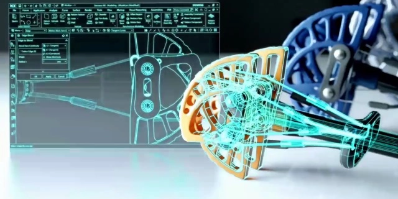Get 30 Day Solid Edge Trial
Access the full version of Solid Edge for 30 days here.
REQUEST A FREE PRODUCT GUIDE
Get Product Guide
Siemens Solid Edge Software provides Engineers with an advanced Design, Manufacturing and Simulation platform: In a single environment.
Solid Edge can transform your product development process by speeding up design time by up to 40%. It is the most flexible, affordable & intuitive CAD platform on the market. Start your Solid Edge journey today.
Learn more about Solid Edge by exploring our downloads. Solid Edge is the leading CAD platform on the market for cost, flexibility, and ease of use. Why wait? Start your Solid Edge journey today.




Solid Edge is an advanced platform to design high-quality, innovative products in a single place that is accessible to everyone in your organisation.
Solid Edge helps you design products, make revisions, and re-use data quicker. Design at the speed of creative thought with best-in-class tools.
The latest generative design and additive manufacturing techniques design complex surface shapes quickly and accurately for world-class products.
Solid Edge delivers the cloud-based capabilities you need for 3D CAD across different devices, with personalised, and easy to share resources.
With value-based licencing, you choose the add-on capabilities you need and easily mix, match, and integrate them all with a flexible token system.
Solid Edge additive manufacturing solutions enable you to create world class products using the latest 3D printing and additive manufacturing techniques.
| 2D Drafting | Design & Drafting | Foundation | Classic | Premium | |||
|---|---|---|---|---|---|---|---|
| Features | |||||||
| Data Management | ✓ | ✓ | ✓ | ✓ | ✓ | ||
| 2D Drafting | ✓ | ✓ | ✓ | ✓ | ✓ | ||
| 3D Part Modeling | - | ✓ | ✓ | ✓ | ✓ | ||
| Synchronous Technology | - | ✓ | ✓ | ✓ | ✓ | ||
| Sheet Metal Design | - | ✓ | ✓ | ✓ | ✓ | ||
| Weldments | - | ✓ | ✓ | ✓ | ✓ | ||
| Frame Design | - | ✓ | ✓ | ✓ | ✓ | ||
| Surfacing | - | ✓ | ✓ | ✓ | ✓ | ||
| Convergent Modeling | - | ✓ | ✓ | ✓ | ✓ | ||
| Generative Design | - | - | ✓ | ✓ | ✓ | ||
| Electrical Routing | - | - | - | ✓ | ✓ | ||
| Mechanical Routing | - | - | ✓ | ✓ | ✓ | ||
| Reverse Engineering | - | - | ✓ | ✓ | ✓ | ||
| Standard Parts Library | - | ✓ | ✓ | ✓ | ✓ | ||
| Assembly Design | - | ✓ | ✓ | ✓ | ✓ | ||
| Advanced Assemblies | - | - | ✓ | ✓ | ✓ | ||
| CAE - Single Part Simulation | - | - | ✓ | ✓ | ✓ | ||
| CAE - Design Simulation | - | - | - | ✓ | ✓ | ||
| CAE - Motion Simulation | - | ✓ | ✓ | ✓ | ✓ | ||
| Keyshot Render | - | - | ✓ | ✓ | ✓ | ||
| 2D Translators | ✓ | ✓ | ✓ | ✓ | ✓ | ||
| 3D Translators | - | ✓ | ✓ | ✓ | ✓ | ||
| Additive Manufacturing | - | ✓ | ✓ | ✓ | ✓ | ||

Access the full version of Solid Edge for 30 days here.
Solid Edge gives you the power to design quickly and intelligently across every aspect of product development. Solid Edge is the complete product design solution set with enhanced functions for seamless and intuitive design.
With a focus on both individual user experience and large assembly performance, with Solid Edge, product development is enhanced by automation and the ease of collaboration.
%2015%25-9.png)
Solid Edge is an advanced platform to design high-quality, innovative products in a single place that is accessible to everyone in your organisation.
The complete design solution, Solid Edge is purpose-built to offer everything you need and want in a design solution, including synchronous technology, generative modelling, additive manufacturing, and reverse engineering.
%2015%25-8.png)

Access the full version of Solid Edge for 30 days here.
Solid Edge gives you the power to design quickly and intelligently across every aspect of product development. Solid Edge is the complete product design solution set with enhanced functions for seamless and intuitive design.
With a focus on both individual user experience and large assembly performance, with Solid Edge, product development is enhanced by automation and the ease of collaboration.
%2015%25-9.png)
Solid Edge is an advanced platform to design high-quality, innovative products in a single place that is accessible to everyone in your organisation.
The complete design solution, Solid Edge is purpose-built to offer everything you need and want in a design solution, including synchronous technology, generative modelling, additive manufacturing, and reverse engineering.
%2015%25-8.png)
In the competitive landscape of industrial machinery, the relentless pursuit of innovation is the hallmark of success. For XYZ Corp, a longstanding player in the industry, this pursuit was no less than a mission.
Faced with the challenge of keeping pace with the rapid advancements in technology, they embarked on a transformational journey that would redefine the way they approached manufacturing.

In the competitive landscape of industrial machinery, the relentless pursuit of innovation is the hallmark of success. For XYZ Corp, a longstanding player in the industry, this pursuit was no less than a mission.
Faced with the challenge of keeping pace with the rapid advancements in technology, they embarked on a transformational journey that would redefine the way they approached manufacturing.

In the competitive landscape of industrial machinery, the relentless pursuit of innovation is the hallmark of success. For XYZ Corp, a longstanding player in the industry, this pursuit was no less than a mission.
Faced with the challenge of keeping pace with the rapid advancements in technology, they embarked on a transformational journey that would redefine the way they approached manufacturing.

It's easy to get started. Installing Solid Edge software usually takes a few hours, depending on your system specifications. Its easy-to-use interface makes user adoption rapid, with most people getting to grips with it in a matter of days.
We’ve got flexible licencing options that suit every need - choose from perpetual, subscription, or rental licences. These options help companies, contractors, SMB’s or even OEM’s use the software in whichever way suits best.
The cost of Solid Edge software varies depending on the licencing options you choose and the tools you need to include. Pricing for Solid Edge starts from an entry price per month on subscription. To get your custom quote, contact us.
As the leading solution on the market, Solid Edge continually pushes the boundaries of product development so you can benefit from all the latest advances. It is updated with hundreds of new features every year.
Solid Edge is versatile and can be used across various industries, including aerospace, automotive, electronics, machinery, and manufacturing, and more. It’s used anywhere detailed 3D modelling and simulation are essential.